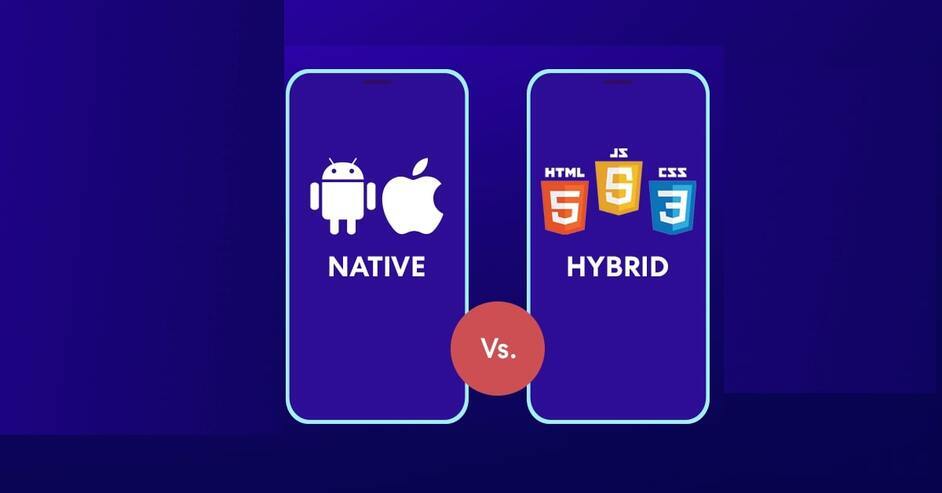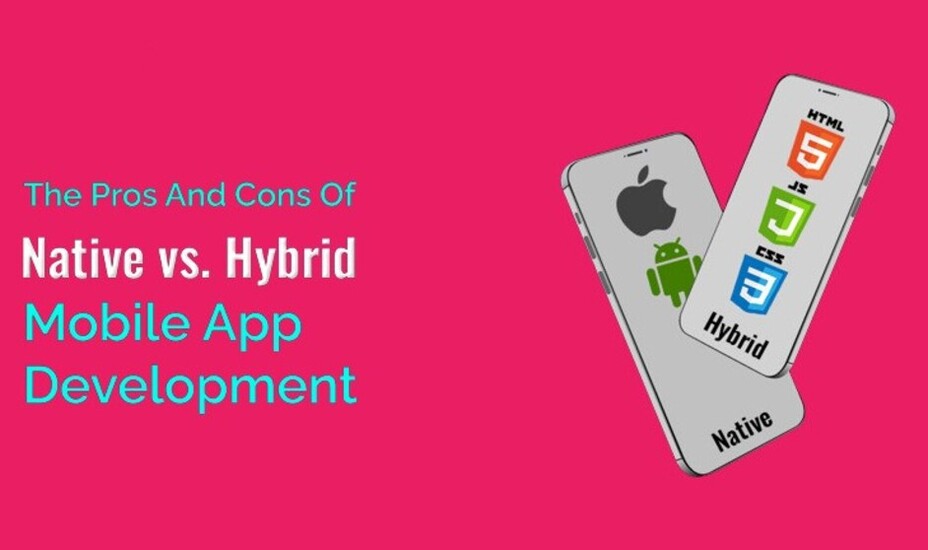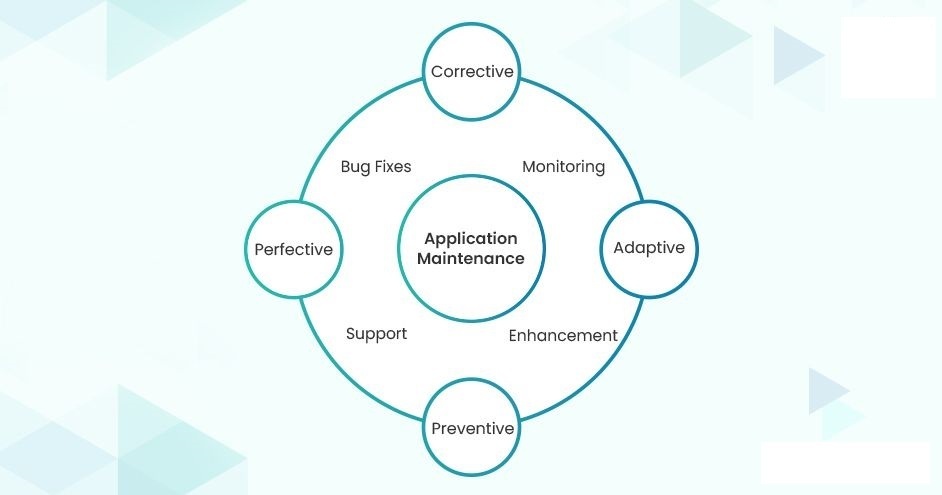New Jersey, USA
-
Location
-
Phone








Native Mobile Apps vs. Hybrid Apps: Which is Right for You?

In today’s rapidly evolving digital world, mobile apps have become crucial for the success of almost any business. When you decide to create a mobile app, one of the first decisions you'll encounter is whether to develop a native app or a hybrid app. Both options have unique advantages and potential drawbacks. Understanding the differences between these two types of apps is essential to making an informed choice that aligns with your business objectives and customer needs. Choosing the right development approach can significantly impact both the performance and the reach of your app, so it’s important to consider your options carefully.
“In the rapidly evolving digital landscape, choosing between native and hybrid mobile apps is crucial for business success. Native apps, tailored for specific platforms, offer optimal performance and enhanced user experiences but come with higher costs and development time. Hybrid apps, using web technologies, provide cross-platform compatibility and cost-efficiency but may lack in performance. Each type has distinct advantages and challenges, influencing user satisfaction and business outcomes. Businesses must consider their specific needs, target audience, and budget to decide the best approach, balancing development costs, performance expectations, and maintenance requirements for long-term success.”
Native Mobile Apps vs. Hybrid Apps

Definition and Features of Hybrid Apps
Hybrid apps, on the other hand, are essentially websites embedded in a mobile app through what is known as a WebView—a browser packaged inside of a mobile application. They are built using standard web technologies like HTML, CSS, and JavaScript. The main appeal of hybrid apps is their cross-platform compatibility. Write once, run anywhere—this means they can be deployed across multiple platforms including iOS, Android, and Windows, using a single code base.
Features of hybrid apps include:
- Cross-platform development leading to reduced development costs and time
- Simpler and faster updates, as the same code affects all platforms
- Integration with web-based services is generally more seamless
- Typically, have a lower upfront cost compared to native apps
Pros and Cons of Native Mobile Apps
Deciding whether to develop a native app involves weighing its benefits against its drawbacks, often considering the long-term implications for both users and the app’s overall performance.
Advantages of Native Apps
Native apps excel in areas of performance, user experience, and feature accessibility, which is why they are often the go-to choice for apps requiring complex interactions or those aiming for the highest quality standards.
- Performance: Native apps are compiled into machine code, which provides the best performance you can get from the mobile device.
- Functionality and Access to Device Capabilities: Native development allows developers to access the full feature set of the selected operating machine, including the processor speed and hardware functionalities like GPS, camera, and microphone.
- User Experience: Native apps are usually more responsive and faster, and they are designed in tandem with the platform’s UX, which typically results in a better user experience.
- Fewer Bugs during Development: Since you’re not relying on a cross-platform tool to work with the device’s hardware, native apps usually have fewer bugs during development.
Disadvantages of Native Apps
Despite the numerous advantages, there are several drawbacks to choosing native app development, particularly regarding cost and resource allocation.
- Cost and Time: Developing a native app is often more expensive and time-consuming as it requires creating app duplicates for each platform.
- Resource Intensive: Maintaining separate development teams and managing updates for different versions of the app can be overwhelming.
- Less Flexibility: Changes or updates in native apps require app version updates to be downloaded by users, which might delay the improvements being experienced by all users immediately.
In technology, as in life, there is no one-size-fits-all solution. The decision between a native app and a hybrid app largely depends on the specific needs and goals of your project, as well as the resources available for development and maintenance. Understanding the differences and implications of each can lead you to make the most informed and efficient choice for your mobile development project.
Pros and Cons of Hybrid Apps

Advantages of Hybrid Apps
Hybrid apps represent a fusion of web technologies and native execution, often regarded as a balanced solution for developers and businesses aiming to reach a wider audience without investing heavily in multiple platforms. One of the primary benefits of hybrid apps is the faster development time. Since these apps utilize a single code base that works across multiple platforms, development teams can save on resources and time. This can be incredibly advantageous for startups or businesses that need to deploy their app quickly across various user bases.
Cost-effectiveness is another significant advantage. Building one hybrid app that operates on both iOS and Android is typically less expensive than developing separate native applications for each platform. Additionally, hybrid apps are easier to maintain. Updates can be rolled out universally through web technologies, bypassing the need for platform-specific updates, which further reduces ongoing maintenance costs and simplifies the process.
Hybrid apps also offer the ability to work offline or with limited internet connectivity — a critical feature for users in regions with unstable network conditions. This broadens the app's accessibility and utility, enhancing user engagement.
Disadvantages of Hybrid Apps
Despite the advantages, hybrid apps come with their own set of challenges and limitations. One of the most notable disadvantages is performance issues. Because hybrid apps load in a webview (a browser within an app), they can experience slower performance compared to native apps, especially in handling complex animations or graphic-intensive tasks. This might result in a less smooth and less responsive user experience, which could frustrate users accustomed to the seamless functionality of native applications.
Another disadvantage is limited access to APIs and device features. While recent developments in technology have improved the capabilities of hybrid apps to interact with device hardware, they still cannot match the level of access and performance that native apps offer. This can affect the app’s functionality and overall user experience, particularly for apps that heavily rely on such features.
Furthermore, hybrid apps often face challenges with app store acceptance. Since they are essentially websites packaged into a native wrapper, some platforms might scrutinize and even reject them if they do not meet specific guidelines or fail to provide a sufficiently "native" user experience.
Performance Comparison
Speed and Response Time
When evaluating the performance of native and hybrid apps, speed and response time are critical metrics to consider. Native apps are developed specifically for their respective platforms, utilizing the platform’s native APIs and tools. This results in optimized performance, with faster execution and smoother interactions. Native apps generally have the upper hand in handling resource-intensive operations and animations, delivering a speedy response to user inputs.
In contrast, hybrid apps tend to have slower response times due to their reliance on webview components. The additional layer between the user’s interaction and the app’s response can lead to noticeable lags, particularly when processing data-heavy tasks or during high user traffic conditions. This aspect can be pivotal in determining the user’s satisfaction and retention, as performance slowdowns during critical interactions might lead to a poor user experience.
User Experience
The ultimate goal of any app developer should be to provide an exceptional user experience, and this is where the differentiation between native and hybrid apps becomes quite stark. Native apps can leverage the device’s hardware and software to their fullest extent, offering a highly intuitive and smooth user interface. This is evident in the fluid animations, timely feedback, and consistent design elements that adhere strictly to the guidelines of the operating system, which enhances the overall user experience.
Hybrid apps, while capable of delivering a reasonable user experience, often struggle to match these levels of integration and fluidity. The dependency on web technologies and the inherent limitations of webview mean that hybrid apps may not always seamlessly align with the operating system's look and feel. Although recent advancements in technology have somewhat narrowed this gap, the difference in user experience quality can still be a deciding factor for businesses and developers focused on maximizing user engagement and satisfaction.
Development and Maintenance Considerations

Developing a mobile app presents unique challenges and decisions, including the choice between native and hybrid approaches. Each approach affects the coding languages you can use, the tools you need, and how maintenance will be handled.
Coding Languages and Tools
Native apps are developed using languages and tools specific to the operating system. For example, iOS apps might be written in Swift or Objective-C, using Xcode, while Android apps commonly use Java or Kotlin with Android Studio. This specificity can lead to optimized performance but requires developers skilled in these particular technologies.
Hybrid apps, on the other hand, are built using web technologies such as HTML5, CSS, and JavaScript. These are then wrapped in a native container, like Apache Cordova or Ionic, which allows them to access some of the native platform features. The advantage here is a significant reduction in the need to learn platform-specific languages. Developers can use a single codebase to deploy across multiple platforms, which can streamline development processes and reduce the need for varied technical expertise.
Upgrades and Maintenance
Upgrading and maintaining native apps can be more resource-intensive than their hybrid counterparts. Each platform's native app must be updated separately, requiring platform-specific knowledge and potentially doubling the maintenance workload. Ensuring compatibility with the latest OS versions and device features often necessitates frequent updates.
Hybrid apps simplify the upgrade process through their unified codebase. Updates can be rolled out simultaneously across all platforms, reducing time and cost. However, they rely on bridging tools like Cordova, which can lag behind in supporting the latest native features until the tool itself is updated. While hybrid apps can be quicker and easier to update in general, significant updates may still require native code tweaks or even complete redevelopment to maintain performance standards and incorporate advanced functionality.
Cost Analysis
Determining the cost-effectiveness of developing a native versus a hybrid app involves numerous factors from initial development to long-term maintenance. Each type of app has its own set of costs based on complexity, required skills, and ongoing maintenance.
Initial Development Costs
The initial costs of developing native apps are typically higher than those of hybrid apps. Developing a native app requires creating a separate app for each platform, which doubles the effort if targeting both iOS and Android. This approach demands more specialized skills and resources, which can increase the expenditure.
In contrast, hybrid apps can often be developed faster and at a lower cost due to the reuse of a single codebase across multiple platforms. Developers familiar with web-based technologies can produce a viable app without needing to understand the intricacies of native development environments, leading to cost savings in human resources and training.
Long-term Expenses
While hybrid apps may be cheaper to develop initially, the long-term costs can vary based on several factors. If the app requires access to advanced device features, frequent updates, or needs to handle complex calculations or large amounts of data, maintaining high performance can become challenging with a hybrid approach. Over time, you may incur additional costs to optimize or rewrite parts of the code for each platform to enhance performance or eradicate persistent issues.
Native apps, conversely, tend to have higher upfront costs but can benefit from better long-term performance and fewer costly updates. Because they are built specifically for each platform, they can more efficiently leverage device capabilities and newer technologies as they emerge. This optimized performance can lead to reduced need for major overhauls or significant debugging over time, potentially leading to cost savings in long-term maintenance.
In either case, the right choice ultimately depends on specific project requirements, target audience, and budget constraints, making a thorough cost-benefit analysis essential for an informed decision.
Market Considerations
When deciding between native and hybrid mobile apps, understanding the market dynamics and considerations is crucial. These considerations not only help in shaping the development strategy but also ensure that the app aligns well with business goals and user expectations.
Target Audience
Identifying and understanding your target audience is foundational in choosing the right development approach. Native apps are specifically designed for one platform, either iOS or Android, which allows them to leverage the full potential of that platform's features and capabilities. This is particularly beneficial if your target audience heavily uses devices specific to one platform and expects a high level of performance and device integration.
On the other hand, hybrid apps are developed using standard web technologies like HTML5, CSS, and JavaScript, and then wrapped in a native container that allows them to operate similarly across multiple platforms. This approach is generally adopted when the target audience is diverse and uses multiple types of devices and operating systems. Choosing hybrid development can be a strategic decision to rapidly reach a broader audience without the need to develop and maintain separate apps for each platform.
App Store Distribution
The distribution strategy also plays a significant role in determining whether to go for a native or hybrid app. Native apps are distributed through app stores like Apple's App Store and Google Play. This not only helps in ensuring security and reliability—since the apps must meet specific standards and criteria before they are approved—but also improves visibility in an environment where users are likely to download apps.
Hybrid apps also benefit from being listed on app stores, but they have the additional advantage of being able to bypass these platforms if needed. Because they are essentially web applications, there's the potential to distribute them directly through a company's website or through third-party app stores, providing greater flexibility in how users can access the app.
Case Studies
Looking at real-world examples can significantly help in understanding the practical applications and advantages of native and hybrid apps in specific scenarios.
Successful Native Mobile Apps
Many popular apps that offer high performance and deep integration with device capabilities are developed natively. A prime example is Pokémon GO. This app leverages the native features of smartphones, such as the GPS and camera, to provide a seamless augmented reality experience that would be difficult to replicate with hybrid technologies. Another noteworthy example is the Waze navigation app, which utilizes the native capabilities of smartphones for real-time traffic navigation and updates, requiring high performance and precision that native development best supports.
Successful Hybrid Apps
Hybrid apps, while sometimes considered less powerful, have also carved out their success stories by delivering cross-platform functionality efficiently. Instagram initially started as a hybrid app before going native to improve performance as its user base grew. The hybrid approach allowed Instagram to launch quickly and scale across different platforms initially. Another example is Uber, which uses a hybrid approach for its app to ensure it can maintain a consistent user experience across iOS and Android platforms while managing just one codebase, simplifying updates and maintenance.
These case studies illustrate that the choice between native and hybrid apps depends significantly on specific business needs, performance requirements, target audience characteristics, and distribution strategies. Whether prioritizing deep platform integration and high performance with a native app or aiming for broader reach and quicker updates with a hybrid app, the decision must align with your overall business objectives and market demands.
Decision-making Guide

Factors to Consider
When deciding whether to develop a native mobile app or a hybrid app, several factors need to be considered to ensure the choice aligns with your project's needs. Here are some important aspects to evaluate:
- Performance Needs: Native apps generally offer superior performance and smoother user experience as they are designed specifically for the hardware they run on. If your app demands high performance for tasks such as heavy graphics or real-time data processing, native may be the way to go.
- Development Budget and Time: Hybrid apps are typically quicker and less costly to develop than native apps because they use a single codebase that runs on multiple platforms. Consider your budget and timeline; if you need to launch on both Android and iOS swiftly and cost-effectively, hybrid might be more suitable.
- Audience Reach: Consider which platforms your target audience uses predominantly. If they are spread across multiple types of devices, a hybrid app can provide the accessibility you need. However, for a market that predominantly uses one type of device, a native app might provide a more tailored experience.
- Maintenance and Updates: Maintaining and updating apps is crucial for performance and security. Hybrid apps allow for easier updates since changes are made to one codebase and reflected across all platforms. Native apps, while requiring individual updates for each platform, can lead to higher stability and fewer bugs.
- Functionality and Features: Some advanced device-specific features and functionalities can only be accessed through native development. Evaluate whether your app needs to integrate closely with the device’s hardware, like GPS, camera, or push notifications, which might be more efficiently utilized via a native approach.
Choosing the Right Solution
Choosing between a native and a hybrid app depends primarily on the factors listed above. Here is a simplified decision pathway to help align your choice with your project goals:
- Identify the primary function and desired user experience of your app. If the app requires complex interactions, high performance, or a sophisticated user interface, consider going native.
- Evaluate your resource availability. If you are constrained by budget and time, and need to reach a broader audience quickly, a hybrid approach can be advantageous. It allows for rapid development and simpler deployment across multiple platforms.
- Consider long-term maintenance. If you anticipate frequent updates or need to constantly add new features, hybrid apps could offer more flexibility and easier scalability. However, for apps that demand less frequent but more intense updates, native could be more practical.
- Your ultimate choice should balance these considerations with your immediate needs and long-term business goals. Each type of app has its strengths and by carefully considering each factor, you can make a decision that not only meets your current requirements but also positions your project for future success.
Conclusion
Choosing the right type of app for your project—whether native or hybrid—depends largely on your specific needs, budget, and timeline. Native apps, built specifically for a platform, offer the best performance and user experience but require a larger investment in time and resources. Hybrid apps, on the other hand, provide a cost-effective solution with faster development times and easier updates, though they may compromise on performance and full utilization of device features.
Carefully weigh these factors the user experience you wish to provide, the complexity of the features needed, and your budget constraints before making a decision. Remember, the goal is to build an app that not only reaches your target audience but also provides them with the most efficient and enjoyable experience possible.
MAD is a top app development company in the USA, a high-performance low-code platform that enables rapid and easy mobile app development compared to traditional coding methods.


